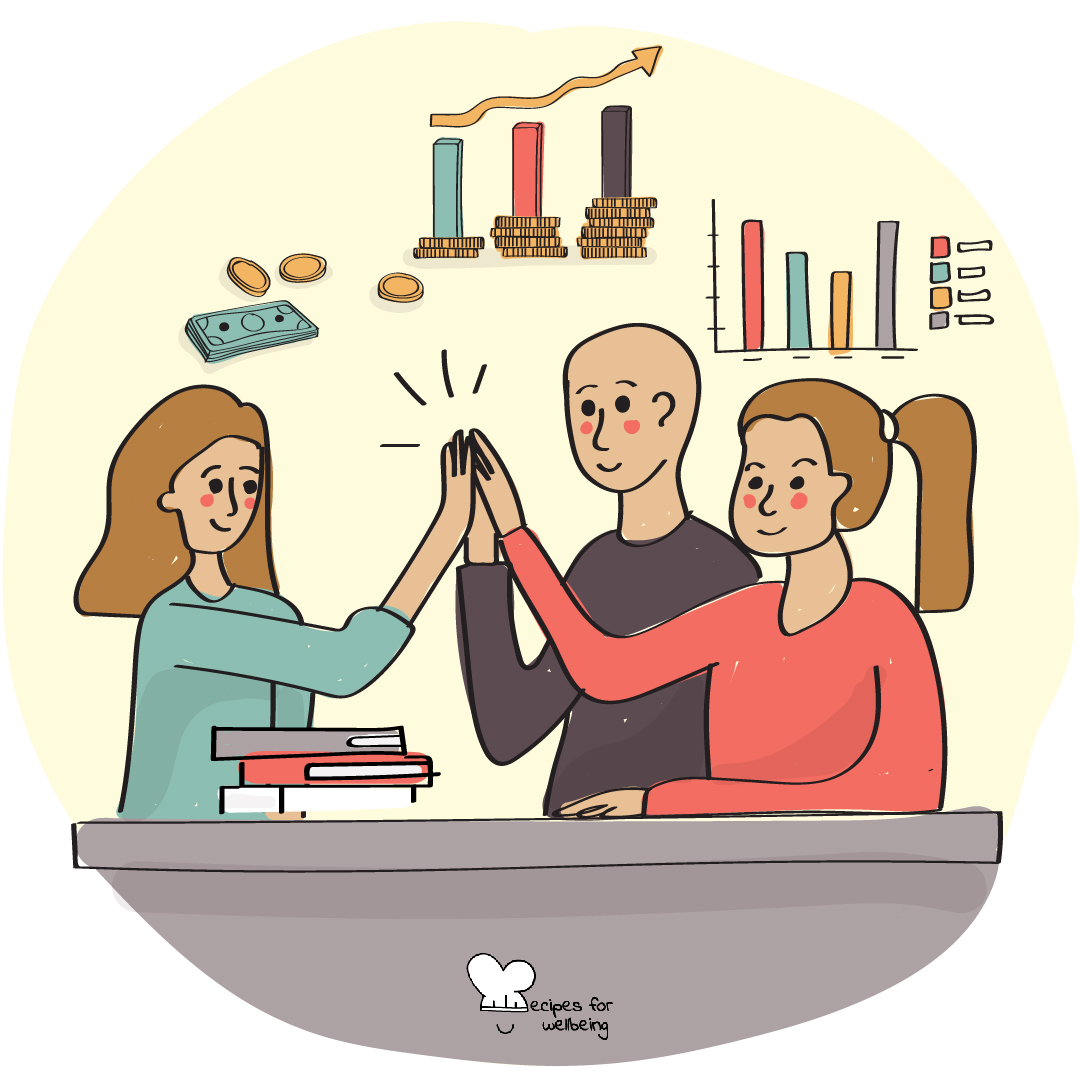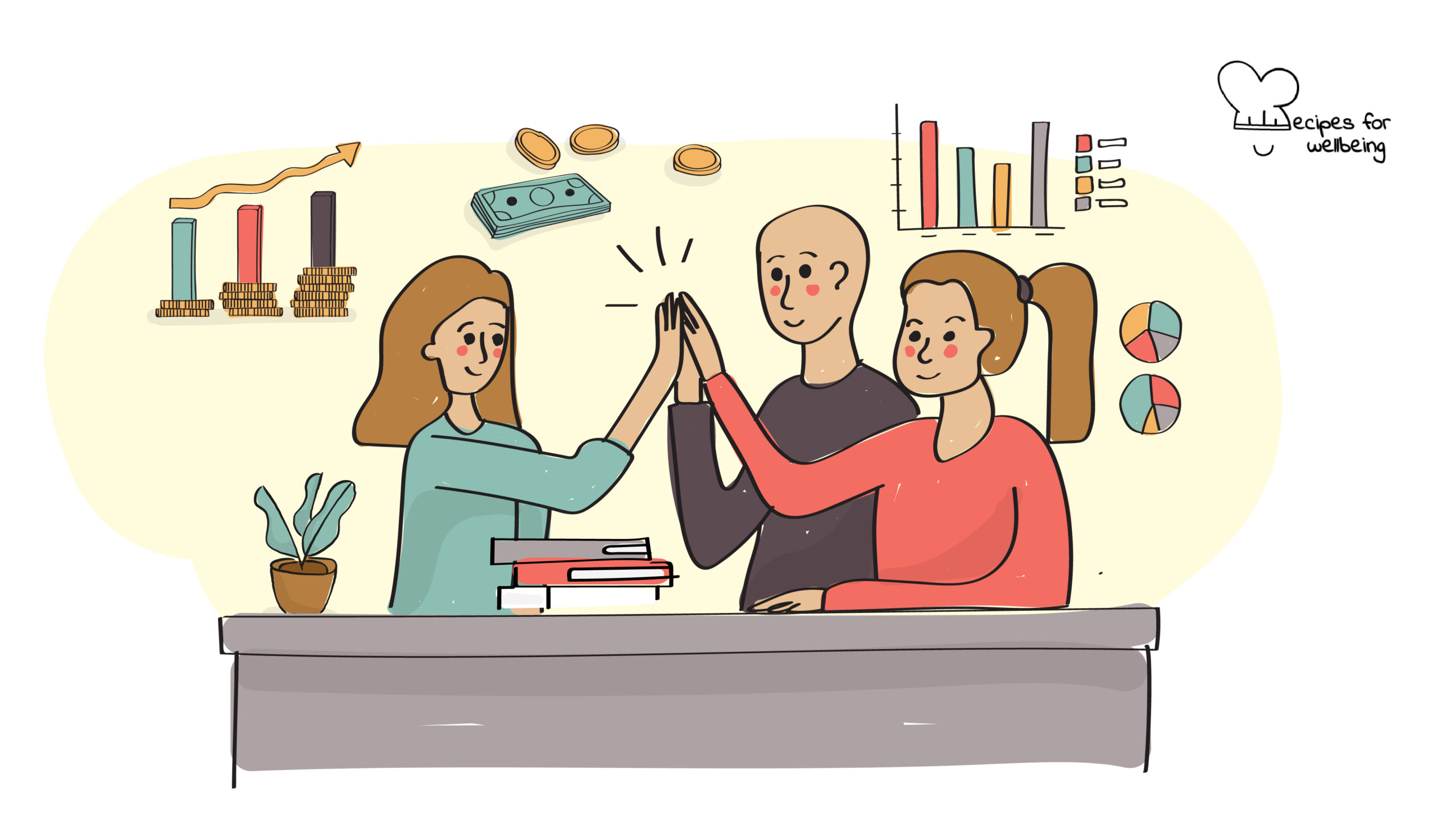
Cultivate a Core Economy
Devote yourself to your community around you and devote yourself to creating something that gives you purpose and meaning. ―Mitch Albom
👥 Serves: 26-40 people, 41+ people
🎚 Difficulty: Medium
⏳ Total time: 61-120 minutes
🥣 Ingredients: Open-mindedness, community members, empathy
🤓 Wholebeing Domains: Community, Meaning, Positive Emotion
💪 Wholebeing Skills: Belonging, Community-building, Equity, Hope, Kindness, Non-extracting, Service

Cultivate a Core Economy
📝 Description
Challenge traditional notions of economy to sustain wellbeing.
Is it possible to move beyond an understanding of economy that relies on transactional relationships and the exchange of money in return for a product or service? That is what the Core Economy is all about!
Core Economy removes the focus on monetised transactions to promote the value of love, empathy, care, and responsibility by looking at the ‘work’ done by families, friends, and communities. How you produce and provide for others has a significant impact on your personal, collective, and future wellbeing. In doing so, it transforms your sense of purpose on earth, improves your social connections, and helps you cultivate healthy relationships with others and the planet.
What is ‘work’ in the Core Economy? It can be any skills or resources that you offer to others such as love, energy, time, empathy, responsibility, care, teaching, learning, reciprocity, and listening. While these exchanges are rooted in families and households, they extend beyond to include extended families friendships, social networks, neighbourhoods, and communities. Core transactions are embedded in networks of intimacy, exchange, and reciprocity, so that, when the core economy is properly operating, the “supplier” does not feel depleted.
⚠️ Warning: It is essential to call out the biggest issue of the Core Economy, which is inequality experienced due to gender, job opportunities, and income that are compounded by age, race, ethnicity, and disability. Core Economy is centred around time – as one needs time to spend their resources on others – and while technically everyone has 24 hours in a day, everyone’s 24 hours are going to look extremely different.
For instance, many women work in low-income jobs in addition to carrying extensive caring responsibilities, making them poor in time and income. This is even stronger for single parents. Some other individuals and groups may be excluded from core economic activities due to their background, education, language barriers, disability, where they live, or their state of health. And certain neighbourhoods might be deprived from spaces (e.g. parks, gardens, community centres) and activities that enrich and strengthen social connections.
Regardless of one’s position in society, the traditional/business economy drains people of their time and their resources. Core economy promises a shift from an economy based on limited economic resources to one of abundance. It places human resources and relationships to the centre and has the potential to really improve people’s well being.
This recipe has been inspired by the work of Neva Goodwin Rockefeller, co-director of the Global Development and Environmental Institute, research associate, and director of the Social Science Library, and has been written by our wellbeing content writer collaborator Marissa Del Mistro.
👣 Steps
Step 1 – Encourage local action (25’)
Most times, when you ask someone what they need or want to improve their life – they will have a list of tangible changes. Creating a space for democratic community groups that can advocate for their needs, control their localities, and help determine priorities for actionable plans is imperative. Check out our recipe “Creating Biocultural Community Protocols” to develop protocols for your group or community.
Step 2 – Build equal participation (25’)
Not everyone has the same privilege of time and ability to support others (except, maybe, those in their immediate family). As a community leader, you should work to put measures in place to encourage, enable, and support all individuals and groups, especially those in challenging circumstances. This can be done by knowledge sharing, distributing materials in an accessible manner, offering training, and support such as free childcare. Another way is to look into a new economic framework called “Community Wealth Building” that places value on individuals and communities to foster wealth through plural ownership of the economy, rather than the traditional individualistic approach.
Step 3 – Change current work expectations and hours (25’)
Working fewer hours in traditional work opens up the chance to spend more time on building core economy practices and spending time doing unpaid activities. To avoid undue stress, consider offering incentives for taking on more staff, limiting paid overtime, training to fill skills gaps, increasing minimum wage, progressive taxation, and flexible working arrangements including job sharing, school term shifts, care leave, and learning sabbaticals You can find inspiration in our recipes “4 tips to avoid WFH burnout”, “Creating a 4 day work week”, “Gender equality through a norm-critical workplace”, “Tips for time management”, “Wellbeing at work”, and “Women’s health and wellbeing in the workplace”.
Step 4 – Preventing versus problem solving (25’)
Sure, problem solving will also need to be a skill, but prevention is key for building a Core Economy. This means there should be opportunities in place in the first instance to support people, strengthen networks, and give people more control. Communities should strive to work with people to bond institutions and citizens together, with the shared intention of avoiding harm and issues. For instance, our recipe “6 causes of burnout” offers useful insights for organisational leaders to identify the root causes of occupational burnout and take action to prevent it.
Step 5 – Examples of Core Economy (25’)
There are so many beautiful examples of community members distributing their resources and skills to better their circle and wider community. Some of these activities are formally organised – for example charities – but they certainly do not have to be. Some examples are:
- Bringing food and medicine to a sick friend
- Grandparents supporting with childcare
- Parents helping out at their children’s school
- Volunteers cleaning parks/shorelines
- Spending time with sick people in hospitals
- Shopping for a neighbour
- Donating free furniture to neighbours
- Visiting a new mother
- Planting trees
- Cooking for your sibling
- Reading and teaching your niece/nephew
- Watering plants for a neighbour
- Holding a house key for a friend
- Helping friends move into a new house
- Care for elderly parents
- Teaching a new skill
- Cleaning a parent’s house
- Sharing advice or tips
You can find even more inspiration in our recipe “Inner happiness”.

